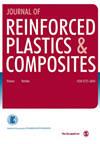微晶纤维素对真空袋压亚麻-黄麻-环氧混合复合材料机械性能的影响
IF 2.2
3区 材料科学
Q3 MATERIALS SCIENCE, COMPOSITES
引用次数: 0
摘要
如今,合成纤维已被混合复合纤维所取代,混合复合纤维具有低能耗、可生物降解、资源可再生、危险性低和易于处理等特点。本研究通过改变亚麻-黄麻-环氧树脂复合材料中微晶纤维素(MCC)颗粒的百分比浓度(0 wt %、2 wt % 和 4 wt %),重点研究其效果。MCC 颗粒与环氧树脂(作为基体材料)和亚麻-黄麻纤维(作为增强材料)混合,用真空袋法制成复合材料板。根据 ASTM 标准,对制成的复合板进行了拉伸、弯曲、冲击、硬度和热重测试。实验结果表明,添加 2 wt % MCC 颗粒后,样品 2 的拉伸强度、弯曲强度和冲击强度均高于样品 1(0 wt % MCC)和样品 3(4 wt % MCC)。可以看出,由于添加了 MCC 颗粒,基体和纤维之间的界面结合良好,从而提高了整体机械性能,这一点在扫描电镜分析中显而易见。同样,亚麻-黄麻混合纤维复合材料的热稳定性也得到了改善,尤其是在添加 2 wt % MCC 的情况下。本文章由计算机程序翻译,如有差异,请以英文原文为准。
Effect of microcrystalline cellulose on mechanical properties of flax-jute-epoxy hybrid composite materials using vacuum bagging
Nowadays, synthetic fibres are replaced with hybrid composite fibres which consist of low energy production, biodegradability, resource renewability, less hazardous and easy handling of manufactured composites. The present work focuses on the effect of microcrystalline cellulose (MCC) particles by varying the percentage concentration (0 wt %, 2 wt % and 4 wt %) in the flax-jute-epoxy composite materials. The MCC particle is mixed with epoxy resin as matrix material and flax-jute fibres as reinforcements in the composite panels fabricated using the vacuum bagging method. The tensile, flexural, impact, hardness and thermogravimetric tests were performed on the fabricated composite panels per the ASTM standard. The experimental results show that with the addition of 2 wt % MCC particle, sample 2 has higher tensile strength, flexural strength and impact strength than sample 1 (0 wt % MCC) and sample 3 (4 wt % MCC). It can be noted that due to the addition of MCC particles, overall mechanical properties improved as a result of good interfacial bonding between matrix and fibres which are evident through SEM analysis. Similarly, thermal stability of the composites also improved in the flax-jute hybrid fibre composites particularly in 2 wt % MCC.
求助全文
通过发布文献求助,成功后即可免费获取论文全文。
去求助
来源期刊

Journal of Reinforced Plastics and Composites
工程技术-材料科学:复合
CiteScore
5.40
自引率
6.50%
发文量
82
审稿时长
1.3 months
期刊介绍:
The Journal of Reinforced Plastics and Composites is a fully peer-reviewed international journal that publishes original research and review articles on a broad range of today''s reinforced plastics and composites including areas in:
Constituent materials: matrix materials, reinforcements and coatings.
Properties and performance: The results of testing, predictive models, and in-service evaluation of a wide range of materials are published, providing the reader with extensive properties data for reference.
Analysis and design: Frequency reports on these subjects inform the reader of analytical techniques, design processes and the many design options available in materials composition.
Processing and fabrication: There is increased interest among materials engineers in cost-effective processing.
Applications: Reports on new materials R&D are often related to the service requirements of specific application areas, such as automotive, marine, construction and aviation.
Reports on special topics are regularly included such as recycling, environmental effects, novel materials, computer-aided design, predictive modelling, and "smart" composite materials.
"The articles in the Journal of Reinforced Plastics and Products are must reading for engineers in industry and for researchers working on leading edge problems" Professor Emeritus Stephen W Tsai National Sun Yat-sen University, Taiwan
This journal is a member of the Committee on Publication Ethics (COPE).
 求助内容:
求助内容: 应助结果提醒方式:
应助结果提醒方式:


